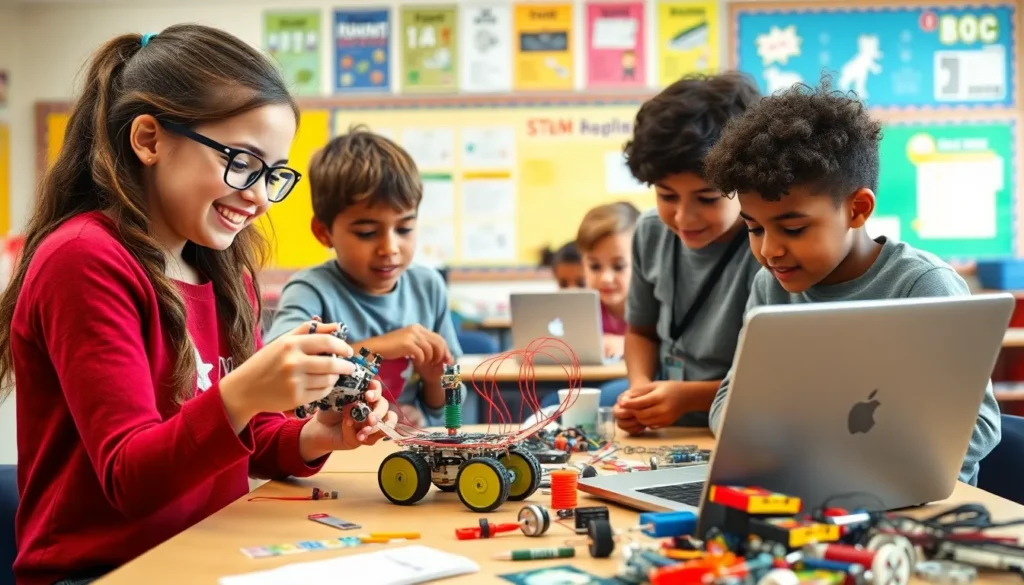Table of Contents
ToggleIn a world where pajamas have become the new business casual, distance learning has emerged as the superhero of education. Gone are the days of battling traffic and trying to find a parking spot. Now, students can attend classes from the comfort of their own homes, armed with nothing but a laptop and a bottomless cup of coffee. Who knew that learning could come with such cozy perks?
Overview of Distance Learning
Distance learning represents a significant evolution in educational methods. This approach allows students to participate in courses remotely, utilizing various technologies. Virtual classrooms enable learners to access materials and communicate with instructors from anywhere.
Engagement occurs through live lectures, recorded sessions, and interactive discussions. Many institutions offer a range of programs to suit diverse needs, from short courses to complete degree programs. The flexibility inherent in distance learning encourages self-paced study, allowing students to tailor their education around personal commitments.
Student support plays a vital role in distance learning. Many platforms provide tutoring, technical assistance, and access to academic resources. Additionally, the integration of social media and forums fosters a sense of community among learners, despite physical distance.
Technological advancements also enhance the distance learning experience. Tools such as video conferencing and digital collaboration software make the learning process engaging and interactive. Data shows that nearly 70% of higher education institutions in the United States offered online courses in 2020.
Distance learning proves particularly beneficial during unforeseen circumstances, such as health crises or natural disasters. With this format, educational continuity remains possible, allowing students to pursue their studies without interruptions. A survey conducted by the Babson Survey Research Group indicated that approximately 35% of students enrolled in at least one online course as of 2019, reflecting a growing trend.
This model of education fosters independence and self-discipline among students. Many learners develop essential skills such as time management and problem-solving, which are invaluable in both academic and professional environments. As distance learning continues to evolve, its potential to transform educational landscapes remains undeniable.
Benefits of Distance Learning

Distance learning offers several advantages that appeal to students and educational institutions alike. It enhances learning experiences in a variety of ways.
Flexibility and Accessibility
Flexibility remains one of the most significant advantages of distance learning. Students access materials and participate in classes at their convenience. This format allows for individualized pacing, accommodating personal schedules and allowing for concurrent work or family responsibilities. Accessibility improves as well, enabling learners from diverse backgrounds to engage with education regardless of geographical barriers. Many programs accommodate those with disabilities by offering tailored resources. Additionally, students can attend lectures from any location, granting opportunities that traditional classrooms may not provide.
Cost-Effectiveness
Cost-effectiveness plays a crucial role in the appeal of distance learning. Tuition for online programs typically falls below that of conventional courses. Students save on commuting and housing expenses associated with attending on-campus facilities. Financial aid options for online education also have expanded, providing further support for learners. Many resources, such as e-books and online libraries, are available at minimal or no cost. With nearly 70% of U.S. higher education institutions offering online courses in 2020, cost considerations contribute significantly to the growing trend of distance learning. This model enables students to pursue their academic goals without incurring substantial debt.
Challenges of Distance Learning
Distance learning presents various challenges that can impact the effectiveness of educational experiences. Identifying these obstacles is essential for enhancing this growing educational model.
Technology Barriers
Access to reliable technology poses significant challenges for some students. In 2020, nearly 70% of higher education institutions in the U.S. implemented online courses. Despite this progress, students in low-income households often lack the necessary devices or stable internet connections. Inconsistent access can hinder participation in live sessions and limit engagement with course materials. Schools must address these disparities through initiatives aimed at providing adequate resources. Additionally, software issues can arise, complicating the learning process further. Educators and institutions should also prioritize professional development for both instructors and students to ensure effective technology use.
Lack of Social Interaction
Distance learning can result in feelings of isolation among students. Students miss opportunities for peer interaction and face-to-face communication. In a traditional setting, collaboration fosters the development of social skills and relationships. The absence of these interactions may hinder students’ sense of belonging and motivation. Many platforms attempt to incorporate discussion forums and virtual group projects, yet these alternatives may not replicate the richness of in-person connections. For educators, fostering engagement through social media and collaborative tools proves essential in creating a more interactive environment. Effectively addressing this challenge is crucial for enhancing student satisfaction and academic success in a remote learning landscape.
Best Practices for Distance Learning
Distance learning can be effective with the right strategies. Implementing best practices enhances student engagement and promotes academic success.
Effective Communication Strategies
Establishing clear communication channels between instructors and students significantly improves learning outcomes. Regular check-ins through emails or discussion boards help maintain engagement. Utilizing video conferencing tools fosters real-time interaction, enabling questions and immediate feedback. Encouraging students to share their thoughts in online forums enhances collaboration. Prioritizing transparency in course expectations and schedules keeps everyone informed and motivated. Institutions can also offer training on effective communication tools, ensuring all participants feel comfortable using technology.
Utilizing Technology and Resources
Leveraging available technology maximizes the distance learning experience. Online platforms often provide a variety of resources, including video lectures and digital textbooks, accessible at any time. Interactive tools, such as quizzes and forums, promote student participation and comprehension. Seeking out additional educational resources, like tutoring services and academic support teams, enhances student understanding. Encouraging students to explore supplementary online learning materials further enriches their educational journey. Staying updated on technological advancements ensures that both educators and learners can benefit from innovative tools that support remote education.
Future Trends in Distance Learning
Emerging technologies shape the future of distance learning, enhancing overall educational experiences. Virtual reality offers immersive learning experiences, enabling students to explore subjects in engaging and interactive ways. Artificial intelligence personalizes education, providing tailored learning paths that adapt to student needs.
Data analytics plays a critical role in monitoring student performance, helping educators identify areas for improvement. Increased use of micro-credentials supports lifelong learning and skill acquisition, allowing students to showcase their talents more effectively. Emerging platforms encourage collaboration among students, fostering a sense of community even in remote settings.
Blended learning models combine in-person instruction with online components, offering a flexible approach that meets diverse learner needs. Increased focus on accessibility ensures that students with disabilities receive the support they require to succeed in distance learning environments. Global access to educational resources continues to grow, breaking down geographical barriers and democratizing education.
As institutions recognize the importance of mental health, enhanced support services will address student well-being in distance learning. Continuous professional development for educators becomes essential, equipping instructors with the skills needed to facilitate effective online experiences.
Growing interest in experiential learning encourages virtual internships and real-world projects, bridging the gap between academic knowledge and practical application. Each of these trends contributes to the transformation of distance learning, ultimately improving educational outcomes for students worldwide.
Distance learning is reshaping the educational landscape in profound ways. Its flexibility and accessibility empower students to pursue their academic goals without the constraints of traditional classrooms. While challenges exist, such as technology barriers and feelings of isolation, the benefits often outweigh these obstacles.
As educational institutions continue to adapt and innovate, leveraging emerging technologies and best practices will be crucial. The future of distance learning looks promising with advancements in virtual reality and personalized learning experiences. This evolution not only enhances the learning journey but also prepares students for success in an increasingly digital world.







